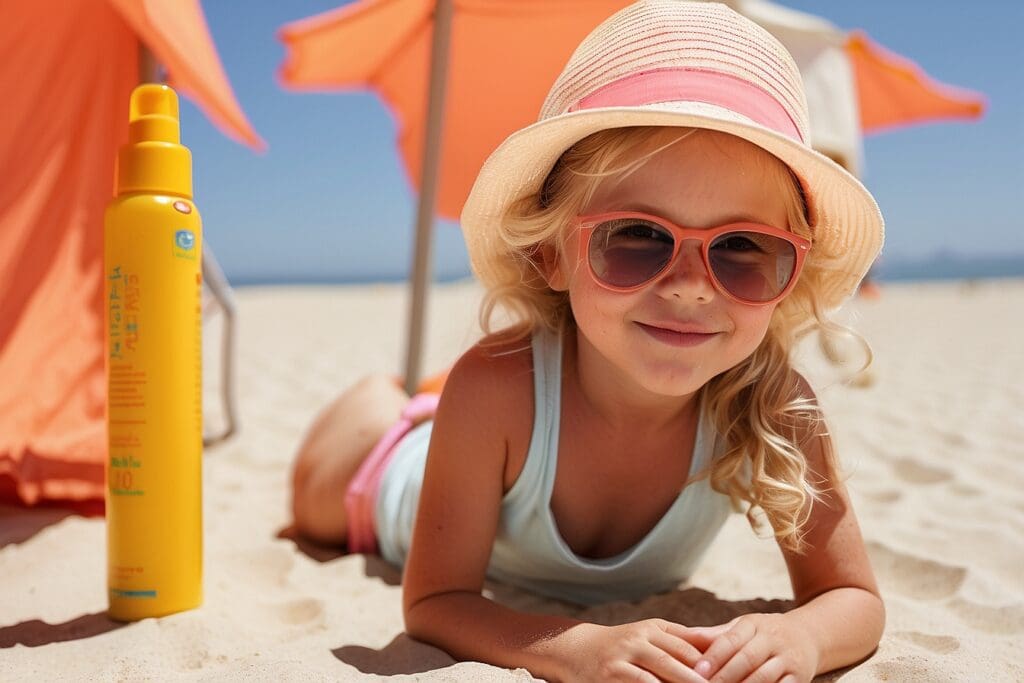Summer is in full swing, and for most, sunscreen is part of the daily routine right now. Because of this, such a product deserves a closer look. What ingredients comprise sunscreen? Are these ingredients harmful to our health? If so, what are safer alternatives?
History of Sun Protection
iHumans used forms of sun protection long before synthetic sunscreen was ever invented. The oldest reference to sun protection was found on Ancient Egyptian papyrus scrolls and tomb walls. The Ancient Egyptians used a combination of rice bran (which absorbs ultraviolet light), jasmine (which repairs damaged DNA), and lupine (which is a mild skin lightener) to protect their skin from burning.1 The Ancient Greeks wore veils and wide-brimmed hats to avoid the sun.2
Before ultraviolet light was discovered, it was believed that the heat of the sun caused sunburn. However, when German scientist Johann Wilhelm Ritter discovered ultraviolet light in 1801, steps slowly began to be made towards making a product that could screen the harmful ultraviolet rays. In 1878, Austrian Otto Veiel published a report on the benefits of using tannins to protect the skin from sun exposure. However, tannins were tossed aside as a sun protector because they stained skin and clothing.3
In 1936, chemist Eugene Schueller, who later went on to found the company L’Oreal, developed a sunscreen that used benzyl salicylate to absorb ultraviolet rays. Two years later, Austrian Franz Greiter created “Glacier Cream” after he got sunburned climbing the Piz Buin mountain.4 In 1944, Benjamin Green, an airman and pharmacist, used red veterinary petrolatum, called “red vet pet,” to protect himself and other soldiers during World War II. Later, he changed the formula of the product by mixing it with cocoa butter and coconut oil to make it more pleasant to wear. He eventually named this product Coppertone.5
Decades later, in 1962, Greiter created the Sun Protection Factor (SPF) scale; his original “Glacier Cream” formula had an SPF of two.6 In 1978, the United States Food and Drug Administration (FDA) began what would be over 30 years of attempts to regulate sunscreens. Most recently, the FDA enacted the Sunscreen Innovation Act (SIA) to create “an alternative process for the review of safety and effectiveness” of sunscreens.7
Current Sunscreen Controversy

Certain sunscreen brands use controversial ingredients. The Environmental Working Group (EWG), a non-profit environmental research organization, has signaled out a few ingredients to look for on labels and avoid:
Oxybenzone – According to the EWG, 56% of beach and sport sunscreens contain oxybenzone. The function of oxybenzone in sunscreen is to absorb ultraviolet light. However, some research has shown that this chemical can be absorbed through the skin; toxicology research has also shown that oxybenzone is linked to hormone disruption and potential cell damage that could lead to skin cancer. The American Academy of Dermatology and the FDA continue to state that oxybenzone is safe for use.8
Retinyl Palminate – This chemical does not make sunscreen more effective, it is an antioxidant that helps prevent skin aging. However, federal government research shows that retinyl palminate may lead to skin tumors and lesions when used on the skin in sunlight. The EWG advises that consumers avoid sunscreens, lip products, and lotions that contain retinyl palminate, which is also referred to as vitamin A, retinyl acetate, retinyl linoleate, and retinol.9
The EWG also warns consumers not to be swayed by high SPF advertisements. Dr. Ariel Ostad from the New York University Medical Center stated of sunscreens with SPF higher than 50, “The protective factors plateau from there. A product with SPF 100+ blocks about 99.1 percent of the UVB rays. You don’t really need a high number. They end up being expensive and don’t offer more protection than SPF 50.”10
It is also important to only buy sunscreens labeled “broad spectrum.” Broad spectrum guarantees that the sunscreen blocks both UVB radiation (which cause sunburns) and UVA radiation (which causes premature skin damage and aging).11 Currently, the U.S. FDA only allows companies to choose from three UVA-blocking chemicals. Companies in Europe have more choice and more effective choices, making their sunscreens better at blocking UVA rays and thus preventing skin damage. While it is true that some European chemicals are not safe and should not be allowed to be used in the U.S., there are some promising chemicals that U.S. sunscreen makers are trying to gain permission to use.12
For a list of EWG-approved sunscreens, click here: ewg.org/2015sunscreen/
Safe Sun Protection Practices
Here are some tips from the Environmental Working Group on how to decrease your ultraviolet ray exposure without resorting to sunscreen:13
- Wearing clothes, such as shirts, hats, shorts, and pants, reduces sun exposure and risk by 27%.
- Finding or creating your own shade. Infants should always be kept in the shade, which reduces their risk of multiple burns by 30%.
- Wearing sunglasses to protect your eyes from ultraviolet radiation.
- Planning your activities around the sun’s schedule – the sun is lower in the sky and less powerful in the early morning or late afternoon.
If you do choose to wear sunscreen, make sure to apply at least two ounces (you will need to pour about 2 good squeezes onto your palms) and to reapply every two hours, or after swimming or excessive sweating. It is also ideal to use a sunscreen with an SPF between 15 and 50.14





